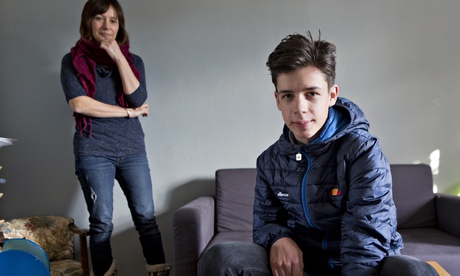
On 13 July last year, the Webber family were enjoying their usual Sunday lunch. Their 13-year-old son, Isaac, was excited about a school adventure holiday, and happy about a recent successful sports day. “He was fit, healthy, a keen footballer. He was never ill,” says his mother, Melanie. Isaac popped to the bathroom. Realising he had been gone for a while she went to investigate – and found him on the floor. “I thought for a spilt second he was messing about, but I realised almost immediately that he could neither move nor talk. He looked very frightened,” she recalls.
Melanie and her father picked up Isaac while her husband, Matt, called an ambulance. Isaac was unable to move his right side and repeated attempts at a smile – “to reassure his dad, I think” – revealed his mouth was drooping on the same side. Paramedics arrived within 10 minutes, by which time Isaac had some – very confused – speech. “He was asked his date of birth and replied: ‘Television.’”
Melanie told the crew that she suspected – correctly – that Isaac had had a stroke. Having worked as a healthcare assistant on a stroke unit, she had seen many affected patients. “Isaac looked just like them.”
Although stroke is the fourth biggest cause of death in the UK, and awareness of its symptoms has improved hugely, its incidence in children – with about 400 cases a year in the UK – is less well known.
Research funded by the Stroke Association, recently published in the Journal of Neurology, Neurosurgery and Psychiatry, found that diagnosis is frequently delayed, and that the routine early use of MRI scans in children with suspected ischaemic stroke – around half of childhood strokes are caused by a blood clot, as opposed to a bleed – could significantly accelerate the process and improve outcomes.
Doctors involved in the research are now formulating new guidelines on treatment – more research, improved awareness and clearer plans are vital to ensure other children like Isaac receive the best possible treatment.
On arrival at hospital, Isaac was becoming harder to rouse, but the doctors did not know why. Melanie, waiting briefly in a relatives’ room, was suddenly terrified. “I had been holding it together until then, but now I was just sobbing. I kept saying it looked like a stroke and the paediatrician explained that was very rare and there were lots of other things it could be,” she says. A CT scan showed no abnormality, ruling out a bleed, and the paediatrician’s request for an MRI scan – which would identify a stroke – was rejected by the radiologist. The decision was taken to sedate and intubate Isaac – reducing brain activity and minimising swelling – and transfer him to the Evelina London children’s hospital for specialist care. An anaesthetist was called.
At this point, a nurse from the stroke ward became aware of Isaac’s case and asked one of the stroke consultants, Dr Ibrahim Balogun, to see him.
“He arrived at the same time as the anaesthetist. It felt as if he was some sort of angel fallen from the sky,” says Melanie. Dr Balogun agreed Isaac urgently needed an MRI. “He was in the scanner for two minutes and 46 seconds and they diagnosed ischaemic stroke.” Five hours had passed since Isaac had collapsed.
Isaac was given thrombolysis – the use of clot-busting medication – a common course of treatment in adult stroke patients, but not in children. “It was very frightening. We were told the drug is only licensed for over-18s and carried a risk of bleeding into the brain, but we felt, given Isaac was healthy and tall, it was the best option. We have since discovered many other doctors would not have thrombolysed him. It shows how badly more research is needed.”
When Isaac woke up concerned that his teacher would be cross about the missed school trip, his parents were cautiously optimistic. Scans confirmed no further damage and Isaac was transferred to the Evelina London for tests to determine the cause of his stroke. A small hole in his heart was found and repaired. Isaac also began speech, occupational and physio therapies.
Six months after his stroke, Isaac is back at school full-time and rebuilding “a normal teenage life”. But, as with 70% of childhood stroke survivors, he does face long-term difficulties. He is still unable to write and has fallen behind at school. Reading and understanding are harder than before, and he suffers from headaches, occasional visual problems and tires very easily. “Initially, growing up was on hold. He just wanted to be with us and feel safe. Within the last month he has felt like going out with his friends more, though, which is really important. We have to let him go, but we worry a lot.”
Dr Vijeya Ganesan, consultant paediatric neurologist at Great Ormond Street hospital, is co-author on the recent research and forthcoming treatment guidelines. While diagnosis and treatment are very streamlined in cases of adult stroke, she believes doctors should be more aware of the possibility of stroke in children presenting with similar symptoms. “The causes are different to those in adults [for whom weight, smoking and diet are major factors]. We need more research into them.”
Isaac, whose stroke was diagnosed by a relatively prompt MRI scan, recently returned to the football pitch, scoring the winning goal for his team. “He talked and talked about it. It was wonderful,” says Melanie. “I remember watching him in hospital and wondering if he would ever be able to play again.”
For more information see www.stroke.org.uk

